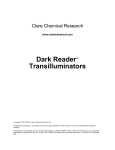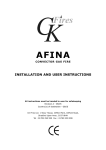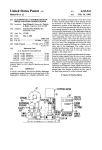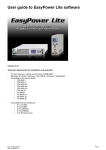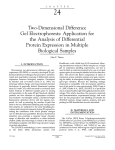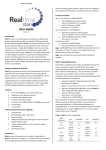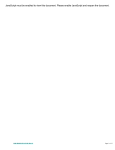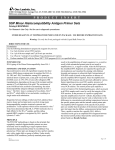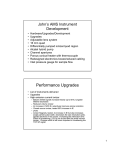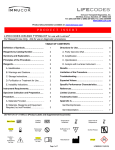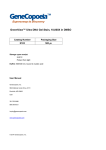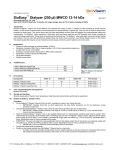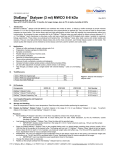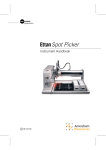Download Dark Reader GelHead™
Transcript
Clare Chemical Research www.clarechemical.com Dark Reader GelHead ™ Copyright 1997-2005 by Clare Chemical Research, Inc. Dark Reader technology is the subject of issued US patents 6198107 and 6512236 as well as US and international patents pending. Dark Reader is a trademark of Clare Chemical Research,Inc., SYBR, SYPRO, Pro-Q, TOTO, YOYO and Alexa are registered trademarks of Molecular Probes Inc., Eugene, OR. GelStar and Gelbond are registered trademarks of Cambrex, Inc. Rockland, ME Table of Contents Safety Instructions...................................................................................................... 2 Basic Instructions for Use.......................................................................................... 4 Overview................................................................................................................. 4 Setting Up the GelHead.......................................................................................... 5 Location......................................................................................................... 5 Place the Combs............................................................................................ 5 Prepare the Agarose & Pour the Gel..............................................................5 Add Running Buffer...................................................................................... 5 Preparing Samples.................................................................................................. 6 GelStar........................................................................................................... 6 SYBR Safe..................................................................................................... 6 SYBR Green.................................................................................................. 6 Ethidium Bromide......................................................................................... 6 Running the Gel...................................................................................................... 6 Load the Samples........................................................................................... 6 Seat the 'Top Block'....................................................................................... 7 Attach the Amber Screen............................................................................... 7 Switch on the Lamp....................................................................................... 7 Run the Gel.................................................................................................... 7 Afterwards...............................................................................................................8 Photography................................................................................................... 8 Excising DNA Bands..................................................................................... 8 Clean-Up........................................................................................................ 8 DNA Dyes.....................................................................................................................9 GelStar................................................................................................................. 9 Using GelStar as an ‘In-Agarose’ Stain.........................................................9 Migration rates of DNA in the presence of GelStar stain.............................. 9 SYBR Safe........................................................................................................ 10 SYBR Green...................................................................................................... 11 Tips on Using SYBR Green........................................................................ 11 Running Buffers for Electrophoresis...................................................................... 13 Troubleshooting........................................................................................................ 15 Service & Parts..........................................................................................................16 Warranty Information............................................................................................. 17 Contact Information................................................................................................. 18 2 Safety Instructions Keep these instructions available for easy reference by any user of this Dark Reader unit. For further assistance contact: Clare Chemical Research 18390 Hwy 145, PO Box 180, Dolores, CO 81323 Tel: 970 882 7499 Fax: 970 882 7068 email: [email protected] web: www.clarechemical.com *** The GelHead lamp operates at 12 V DC, 1.2 A only. The AC-DC adapter for the lamp in the GelHead is rated for use at 100 - 240 V, 50-60 Hz, depending on country. Check the voltage rating on the label. *** The lamp in the DG345 uses a low voltage 12 V DC power supply. However, actual electrophoresis (as you already know) is typically conducted at 100 V or more. This is potentially lethal! DO NOT GET THE 2 VOLTAGES CONFUSED. *** The GelHead is designed to be used by individuals who are experienced in using similar devices to fractionate and view stained DNA samples. Do not let untrained personnel operate this device! *** As with any electrophoresis device, a potentially lethal voltage is present across the gel bed during operation. Do not attempt to make contact with electrically uninsulated areas of the unit such as the running buffer, electrodes and connection leads! Always use the amber screen to connect to the electrophoresis power supply. The screen functions not only to enable viewing of fluorescent samples but also to protect the user from the high voltages required during electrophoresis. *** To prevent damaging the electrodes in the GelHead, be sure to attach and remove the amber screen by gripping it at both ends so that the attachment (or removal) occurs simultaneously at both electrodes. Do not stress the electrodes with bending forces. *** Always ensure that the amber screen is disconnected from the power supply before attaching or removing the amber screen from the GelHead. *** Do not overfill the GelHead with buffer. The buffer level only needs to be JUST above the ends of the gel tray. This requires about 200 mL of buffer (assuming the Top Block is in place). *** During electrophoresis, do not allow a current of more than 50 mA or a voltage greater than 300 V to pass through the GelHead. *** Measurements show that the Dark Reader GelHead emits less light in the UV (light below 400 nm) than the standard fluorescent tubes used in most offices and laboratories. However, the blue light emitted is fairly intense and it is unwise to look at any bright light source for 3 extended periods of time. The GelHead is intended only for use with the amber screen. *** The only replaceable component in the GelHead shell is the lamp. If the lamp fails to start, seek advice from CCR technical support at the number given above before attempting to open the unit. Disconnect the unit from the power supply before attempting to open. *** The GelHead is not designed to be used in the bath! Though the unit is designed to be waterproof, great caution must be taken when using near liquids. Do not allow the wall adapter jack to sit in pools of liquid on the bench-top as this may trip the safety features of the wall unit transformer and a replacement will be required. In addition, salts in the liquid can corrode the jack. For the same reasons, the contact of any liquids with the 12 V DC socket on the GelHead itself should be avoided. *** Do not place the DG345 containing buffer in an imaging system compartment. These imaging systems are not designed for such purposes! *** Switch off the lamp in the GelHead after use to prevent over-heating. *** The DG-345 has not been designed to withstand substantial impact so do not drop it on the floor! Any impact could affect the structural integrity of the unit causing it to leak. *** Do not forget to disconnect the wall transformer and electrophoresis power supply before attempting to move the GelHead to a different location! *** Though data published by Molecular Probes show that SYBR® Green is significantly safer than ethidium bromide, it should be remembered that any dye that stains DNA is likely to be hazardous. Gloves should be worn when handling solutions or gels containing such dyes. Always follow the suppliers instructions for use. *** The glasses are ONLY for viewing in conjunction with DARK READER Products. They are NOT safety glasses and do NOT provide eye protection. Do not use in conjunction with UV-emitting devices. 4 Basic Instructions for Use Questions? - Do not hesitate to contact us: Clare Chemical Research 18390 Hwy 145, PO Box 180, Dolores, CO 81323. Tel: 970 882 7499 Fax: 970 882 7068 email: [email protected] web: www.clarechemical.com Overview Familiarize yourself with the parts of the Dark Reader GelHead as describes on the accompanying Parts Checklist sheet and read the Safety Instructions (pages 2-3 of this manual) before using your Dark Reader GelHead! 5 Setting Up the GelHead Location Place the GelHead on a level surface in a room that can be darkened for the most sensitive detection of DNA fluorescence. Ensure that the GelHead, especially the gel tray, is free of dust particles. Some DNA dyes fluoresce brightly upon contact with dust particles. Place the Combs Attach the gel comb to the comb support using the screws supplied. Ensure that the pegs on the comb support are straight and that they slide easily in and out of the holes in the side-walls of the GelHead. The combs should be adjusted until they are central across the gel bed and level, about 1 mm above the surface of the gel bed. Remember, DNA migrates towards the red (positive) electrode. (There are 2 positions for combs, allowing up to 34 samples to be analyzed in a single run. Extra comb sets are available.) Occasionally, the comb may stick to the agarose sufficiently when removing the comb to slightly lift the agarose from the bed. This can be avoided if the comb washed well before use and treated with Sigmacote® (Sigma-Aldrich #SL-2). Prepare the Agarose & Pour the Gel We typically store agarose in 50 mL screw-cap tubes. The agarose gel can be ‘slid’ out of the tubes into a glass beaker to be re-liquified. Carefully pour melted agarose (50 mL) into the gel tray and allow to set. Note: the gel bed is not sufficiently deep to run a gel more than about 6 mm (0.25”) thick. Do not overfill the gel tray with agarose. The capacity of the tray is 50 mL. If the DNA samples are to be visualized using GelStar, SYBR Safe or EtBr, the stain should be added to the melted agarose BEFORE it is poured into the tray: GelStar - The agarose should be allowed to cool to around 60 oC before adding a 1:10,000 volume of GelStar stain (5microL of GelStar for 50 mL of agarose). Mix well before pouring the gel. (Remember to wear gloves when handling DNA-binding stains.) SYBR Safe - SYBR Safe dye is provided as a ready-to-use aqueous solution in 0.5 x TBE buffer. Because SYBR Safe is stable to both the heating that is involved in preparing molten agarose as well as storage in aqueous solution, a batch of agarose containing stain can be prepared ahead of time and stored in aliquots for immediate use whenever needed. After the gel has set (about 20 min., depending on the type of agarose used), carefully remove the comb. This involves slightly ‘wiggling’ the comb as it is very slowly pulled from the gel. To avoid the gel sticking to the comb, it can first be treated with Sigmacote® from Sigma. Add Running Buffer Carefully pour about 20 mL of running buffer directly on top of the agarose and make sure there are no air bubbles trapped in the wells. Pour running buffer into the 2 reservoirs until the buffer JUST flows over the ends of the gel tray (about 200 mL total). Do not overfill! For neither SYBR Green, SYBR Safe nor GelStar is there a need to add the dye to the running buffer. 6 Once running buffer has been added, the GelHead should not be moved, except to dispose of the running buffer. Remember to disconnect the GelHead before moving! Preparing Samples In general, do not add excessive amounts of tracking dye to the samples as the colorant can obscure fluorescent bands. Indeed, a dye is not required for tracking purposes - the DNA bands will be directly visible as they migrate through the gel! We especially recommend using loading buffer from which the xylene cyanol is omitted as this dye tends to migrate in a similar position to many DNA fragments. GelStar If the gel contains GelStar then the samples (containing loading buffer) can simply be loaded onto the gel. Because the DNA must enter the gel before becoming fluorescent, it will be a couple of minutes after the gel has been started before any fluorescence is visible. See the attached sheets for further information on GelStar or visit: www.clarechemical.com/gelstar.htm. SYBR Safe As with a GelStar gel, the samples are simply loaded onto into the wells. SYBR Safe is not as sensitive as GelStar. See the attached sheets for further information on SYBR Safe or visit: www.clarechemical.com/safe.htm. SYBR Green If the DNA is to be pre-stained with SYBR Green, make a fresh 1:100 dilution of SYBR Green in 1xTAE. (Remember to wear gloves when handling DNA-binding stains.) Add 1 microL of this solution to each 9 microL of DNA sample + sample loading buffer. Incubate for a few seconds before loading onto the gel. See the attached sheets for further information on SYBR Green or visit www.clarechemical.com/green.htm. Ethidium Bromide The GelHead can also be used to view ethidium bromide (EtBr) stained DNA if dye is added to the running buffer and agarose (Remember to wear gloves when handling DNA-binding stains.). The optimal concentration of ethidium bromide is 0.1 - 0.2 microg / mL. (We have found that using EtBr at greater dilutions than is typical, reduces the background level of fluorescence from the gel leading to better sensitivity.) The GelHead is not as sensitive as a UV unit for viewing EtBr-stained DNA. See the attached sheets for further information on EtBr or visit www.clarechemical.com/ethidium.htm. Running the Gel Load the Samples Carefully load the samples onto the gel. The 17-well comb creates wells that hold about 15 microL of sample, the 10-well about 30 microL, and the 6-well about 60 microL. Be careful not 7 to puncture the bottom of the well with the pipette tip! Samples loaded into the wells at the extreme edges of the gel can result in ‘smiling’ at higher voltages. Seat the 'Top Block' The 'Top Block' is the block of clear plastic about 3" x 5" and 0.75" thick included with the GelHead. While the gel is running, the Block should be in position across the top of the agarose. The Block serves 2 functions: - by excluding buffer from above the gel, all the current will pass through the agarose. This leads to faster separation times and sharper bands. - the Block prevents condensation from forming on the underside of the amber screen so a clear view of the DNA bands is maintained. After the samples have been loaded carefully lower the Block into place. There are guides on the side-walls of the GelHead that facilitate this. Start with the Block at an angle of about 20 degrees in contact with the guides at one end of the tray. Gently lower the other end of the Block down on top of the agarose in the gel tray. Attach the Amber Screen Make sure exterior surfaces are free of liquid, including the recessed electrodes. Then place the amber screen carefully onto the unit by pushing the female connectors onto the male connectors on the gel box. This should be done by gripping the amber screen at both ends and guiding the screen onto the gel box, using the sides of the gel box as guides to keep the screen parallel to the box as it slides on. When attaching and removing the amber screen, keep the screen as parallel as possible to the GelHead to avoid putting undue bending stresses on the electrode connectors. Switch on the Lamp Insert the input jack of the GelHead wall adapter unit into the socket on the GelHead. Plug the GelHead wall adapter unit into a wall socket. To turn on the lamp and view DNA bands, place the GelHead magnetic switch into the holder on the end wall of the GelHead base. Sensitivity is maximized by darkening the room. Turn the lamp off (by removing the magnetic switch) when not viewing the gel to avoid unnecessary heating effects. Run the Gel Make sure the power supply to be used to deliver the voltage across the gel is switched off and the voltage setting dial or control is at zero. Then attach the black (-) and then the red (+) cables of the amber screen to the appropriate outputs on an electrophoresis DC power supply. Switch on the electrophoresis power supply and bring the applied voltage up to the desired value. For example, using 1 x TAE buffer, a voltage of 100 V will adequately separate DNA fragments in less than 60 min. The initial current reading on the power supply should be about 28 - 34 mA. Other running buffers besides 1xTAE can be used, including 0.5xTBE and HS Buffer from Cambrex, Inc. (The running buffer should be the same as the buffer used to prepare the agarose.) Both TBE and HS buffers can be used at higher voltages than TAE and separation times will be correspondingly quicker as described in the attached sheets. (The actual separation time required 8 will depend on a number of factors besides the voltage applied to the gel including the complexity of the sample, the amount of sample and the choice of agarose.) If the amps meter on your power supply reads zero at this point, you do not have a complete electrical circuit. Before checking for ‘break points’, disconnect the power supply leads. Here are some possible break points: There is insufficient running buffer to cover the ends of the gel tray. Add a little more running buffer. You have the power supply leads plugged into the other set of outputs on your power supply (!) You forgot to add buffer concentrate to your running buffer and distilled water is a fairly good insulator (!) The amber screen is not properly seated on the GelHead. Afterwards After the electrophoresis run is complete, turn off the high voltage supply. Disconnect the amber screen from the supply before removing the amber screen. To remove the amber screen from the GelHead, grip the edges of the screen on either side of the electrodes and carefully raise Photography First disconnect the electrophoresis high voltage power supply! Any type of imaging equipment such as a digital camera or Polaroid camera can be used to photograph the gel. Any non-Dark Reader filter attached to the camera should be removed - the amber lid of the GelHead provides the optimal color filter. Separate DR camera filters are also available - www.clarechemical.com/ filters.htm If necessary, a Polaroid camera hood can be placed on the amber screen. To achieve focus of the gel using such a hood with a fixed-focus camera requires an f-stop of 16 - 22 to achieve a sufficient depth of field. Using Polaroid 667 film, and a high f-stop, the exposure time needs to be 20 secs plus. With standard digital cameras, the DNA bands can be manually focused allowing a lower f-stop to be used. More information on digital imaging with the Dark Reader is available at: www.clarechemical.com/imaging.htm Excising DNA Bands This is obviously best done using the glasses. Care should be taken to remove the amber screen (switch off the power first!) by gripping at both ends while removing and then pulling the screen off evenly. This will ensure that the connectors are not bent. If the gel is to be moved from the gel tray, a scoop is provided. Clean-Up Dispose of materials potentially containing DNA stains according to the manufacturers instructions. All components of the GelHead that have potentially been in contact with DNA stains should be washed in soap and water, rinsed in distilled water and allowed to dry. Do not forget to disconnect the Gelhead before moving it! 9 DNA Dyes GelStar Using GelStar as an ‘In-Agarose’ Stain GelStar works very well as a stain if the dye is added to the agarose before electrophoresis. The use of GelStar rather than SYBR Green as a pre-stain has 2 advantages: - The sensitivity of DNA detection achieved with GelStar pre-stain is much higher than with SYBR Green. In fact, the sensitivity is almost the same as that achieved with post-staining - less than 20 pg of dsDNA using a CCD camera and as little as 100 pg can be seen directly by eye. - The presence of GelStar stain does not significantly affect the migration behavior of DNA samples prepared by typical laboratory protocols such as plasmid preps. and PCR (see the Figures below). Consequently, pre-staining with GelStar is the recommended technique for the rapid and accurate determination of the sizes of fragments in DNA samples. Cambrex has recently introduced a line of pre-cast agarose gels containing GelStar stain (Reliant HS Gel Systems). These gels are very attractive for their simplicity and speed. Using a Reliant gel, the agarose preparation time is eliminated, staining time is eliminated and the gel only need be run until the bands of interest are separated - about 15 - 50 min, depending on the complexity of the sample and the running buffer used. The total time saved can be over 2 hours, start to finish. Migration rates of DNA in the presence of GelStar stain GelStar pre-stain EtBr post-stain 400 350 GelStar pre-stain 300 250 200 150 EtBr post-stain 1,000 10,000 DNA fragment size (bp) The amount of DNA loaded onto the GelStar gel shown above is clearly too high.This is a direct consequence of the greatly enhanced sensitivity of GelStar versus EtBr for the detection of DNA. In practice, the amount of DNA loaded onto a GelStar gel can be reduced 5 - 10 fold. Reduced 10 DNA loading levels can result in considerable savings in the cost of expensive reagents. Of course, if one is attempting to locate minor DNA products in, for example, a 50 µL PCR reaction, then the increased sensitivity of GelStar will allow the visualization of DNA fragments that are simply undetectable with EtBr. SYBR Safe ’Safe’ is the latest addition to the SYBR stain family and has a number of very attractive benefits: Increased safety - Data released by Molecular Probes show that SYBR Safe stain is negative in 3 different mammalian cell-based assays for genotoxicity and exhibits low mutagenicity compared to EtBr in Ames tests. Furthermore, SYBR safe has been extensively tested for environmental safety and is NOT classified as hazardous waste under U.S. Federal regulations. Flexible usage - SYBR Safe can be used either to stain a gel after running or, for the fastest results, it can be used as an‘ in-agarose’ stain. High stability - Safe is stable for over 6 months in aqueous solution and is also stable to the heating involved in preparing molten agarose. Adding SYBR Safe to the agarose before electrophoresis has a number of advantages: - DNA bands can be directly visualized as they migrate through the gel using the Dark Reader GelHead. An electrophoresis run can be halted as soon as the desired DNA bands are separated often within 30 minutes. - Because SYBR Safe is stable to both the heating that is involved in preparing molten agarose as well as storage in aqueous solution, a batch of agarose containing stain can be prepared ahead of time and stored in aliquots for immediate use whenever needed. This feature makes SYBR Safe the quickest and most convenient of all the new DNA dyes. In the Figure above, 0.5 g of agarose was added directly to 50 mL of SYBR Safe stain solution and heated in a microwave for about 1 minute. The molten agarose solution was then poured into the bed of a Dark Reader 11 GelHead. The gel was loaded with a 2-fold dilution series of a 1 kb DNA ladder (ISC BioExpress) starting with 100 ng of total DNA and then run at 200 V for 30 minutes using 0.5 x TBE running buffer. The DNA detection sensitivity using SYBR Safe is comparable to EtBr using this method - about 1 ng by eye and 0.5 ng using a CCD camera. SYBR Green Adding SYBR Green directly to DNA samples before electrophoresis has a number of advantages: - DNA bands can be directly vizualized as they migrate through the gel using the DR GelHead as shown on the right. An electrophoresis run can be halted as soon as the desired DNA bands are separated - often within 30 minutes. - Unlike ethidium bromide (which when used as a pre-stain must be added to the gel and the running buffer) SYBR Green need only be added to the DNA samples. This drastically reduces the amount of dye required and virtually eliminates the risk of toxic spills. - By avoiding the post-staining step, electrophoresis results are obtained immediately. - SYBR Green is very economical to use as a pre-stain (about 0.3 cents per sample). Time (min) Tips on Using SYBR Green 1. For best results when pre-staining, use a dilution of 1:1,000 of SYBR Green in the DNA sample. In the CCR lab, we keep a stock of 1:100 SYBR Green in DMSO and add 1 uL of this for every 9 uL of DNA. The DMSO does not appear to affect the DNA. 2. Run the gel in less than 2 hours. During overnight runs the SYBR dye tends to dissociate from the DNA resulting in smeared bands. 3. When used with DNA samples generated by typical laboratory procedures such as PCR and plasmid preps., the migration of DNA fragments becomes more unpredictable. For the rapid and 12 accurate determination of DNA fragment sizes, the use of GelStar as a pre-stain is recommended. 4. Using SYBR Green as a pre-stain, the sensitivity of detection is not as high as with poststaining. It is possible to see about 300 pg of dsDNA by eye. 13 Running Buffers for Electrophoresis The most common running buffers for agarose gel electrophoresis are 1 x TAE* and 0.5 x TBE**. Another buffer - Reliant HS buffer - has been recently introduced by Cambrex, Inc. and is a proprietary formula***. All these buffers perform well with the GelHead. The biggest difference we have found is in the voltage that can be applied to the gel and still achieve a sufficiently low current to avoid excessive heating of the gel. In general, a higher voltage across the gel will result in a shorter separation time as shown by the data in the table below. Buffer Voltage (V) Initial Current (mA) Typical Run Time (min) 1 x TAE 100 28 60 0.5 x TBE 180 28 40 1 x HS 300 24 25 A gel run for 60 min at 100 V (initial current, 28 mA) using 1 x TAE running buffer, with the GelHead lamp switched on intermittently when the gel is actually being viewed, will reach a temperature of about 32 oC. With the lamp on continuously during the electrophoresis run, the temperature will rise to approx. 39 oC . Temperatures above 40 oC should be avoided as this can lead to a loss of sensitivity of the fluorescent stain. The buffering capacity is an additional factor to consider when choosing a running buffer. During electrophoresis, the pH of the buffer at the anode (-) will tend to increase and the pH at the cathode (+) will tend to decrease. Excessive pH changes can lead to collapse of the gel at the anode and loss of fluorescence at the cathode. 1 x TAE has the lowest buffering capacity and is good for about 75 minutes at 100 V. TAE TBE HS Patterns obtained using a DNA molecular weight standard and a variety of running buffers. Conditions are listed in the table. 14 * 1 x TAE: 40 mM Tris-Acetate, 1 mM EDTA, pH 8.4 ** 0.5 x TBE: 44 mM Tris-Borate, 1 mM EDTA, pH 8.4 *** 1 x HS buffer: 10-fold dilution of concentrate (10x) HS buffer. Cambrex part number 50892 15 Troubleshooting Problem No current is flowing through the GelHead (mA meter on your power supply reads zero.) Fluorescence is difficult to see. Fluorescent bands are fuzzy and indistinct. Cause Solution Electrical circuit is not complete because: - There is insufficient running buffer Add a just enough running buffer to to cover the ends of the gel tray. the reservoirs to cover the lip of the gel bed. - You have the power supply leads plugged into the other half of your power supply (!) Reconnect. - You forgot to add buffer concentrate to your running buffer and distilled water is a fairly good insulator (!) Difficult to fix. Start again. - The amber screen is not properly seated on the GelHead. The room needs to be darker. Carefully seat the amber screen. Condensation is forming on the underside of the amber screen because the Top Block is not in place. Switch off overhead lighting. Set up the GelHead away from windows. Stop electrophoresis. Disconnect the power supply. Remove the amber screen and wipe the undersside with a tissue. Position the Top Block and restart electrophoresis. Fluorescent 'smudges' on the gel bed Fluorescent dye is present on the surface. surface. DNA bands are smeared. Fluorescent bands in the gel seem to gradually disappear when viewing the gel. No light from the gel bed. Photograph of gel does not look as good as when just viewing by eye. The photo is very dark. The photo is very light. Image is not in focus. Wipe the surface with a little ethanol. Rinse the gel briefly in water to remove excess dye. The gel is overloaded. The new DNA Try loading ~5 times less sample dyes are much more sensitive than onto the gel. EtBr. Condensation is forming on the Be sure to use the top block. underside of the amber screen. The lamp may be broken. Replace the lamp (see page 16). If this fails to correct the problem, contact CCR. There are several possible causes but, See the Photograph Section for more in general, if a photograph does NOT information. (Pages 8 ) as well as look as good as when viewed by eye, items in this list. photographic conditions need optimizing. Not enough light is reaching the Make sure you are using only amber camera. screen as a camera filter. Increase the exposure time. Decrease the f-stop. Too much light is reaching the Make sure you are using only amber camera. screen as a camera filter. Decrease exposure time. Increase f-stop. The usual causes are using autoWith a digital camera, set the focus focus or using too low an f-stop. manually. With a fixed focus camera, increase the f-stop. 16 Service & Parts Remember to disconnect the unit from the electric supply before replacing any parts! If you have any questions, contact Clare Chemical Research. The lamp is the only user-replaceable part. All other problems require that the unit be returned to Clare Chemical Research for servicing. Replacement lamps are available from Clare Chemical Research. Do not use a lamp with other specifications. NOTE: if a lamp is broken, some of the glass may be a very fine dust. DO NOT WIPE THE INSIDE OF THE BOX! Wear a pair of gloves and protective glasses when cleaning up broken glass. DO NOT TRY TO BLOW THE DUST OUT OF THE BOX! A vacuum cleaner is the best way to remove glass fragments. Disconnect the unit from the power supply! Wear gloves and protective glasses! Turn the unit upside-down and take out the screws that secure the GelHead to the base. Turn the unit right-side up (hold the GelHead in place) Removing the GelHead from the shell reveals 2 gaskets and a white diffuser screen. Remove the diffuser screen. Remove the lamp from its socket by gently pulling on the lamp. Put in a new lamp by gently pressing the lamp into the socket. The lamp 'clicks' into place. After installing the new lamp, reassemble the unit. and replace the screws. Do not over-tighten the screws!. Only now can you switch the GelHead on. If the new lamp fails to light, contact Clare Chemical Research. 17 Warranty Information If you are not satisfied with the Dark Reader GelHead for any reason, return it within 30 days for a full refund (less shipping and handling). The DR GelHead parts and workmanship are guaranteed for 1 year from the date of purchase. (See details below.) Please fill out the warranty card and send it back to Clare Chemical. To obtain warranty service contact Clare Chemical (see p.18) and obtain a Return Form. Ship the unit to Clare Chemical postage prepaid, together with a completed Form. All products returned for warranty service must be carefully repackaged in the original packing materials: Clare Chemical Research makes the following limited warranties. Clare Chemical Research products are guaranteed to be free of defects in materials and workmanship under normal use for period of 1 year after the date of original purchase. During this period Clare Chemical will repair or replace a defective product or part without charge to you. The warrant conditions and limitations are set out below: The warranty applies only to defect in material or workmanship and does not include normal wear. The warranty applies only to defects which occur during normal use and does not extend to damage to products or parts which results from alternation, repair, modification, faulty installation or service by anyone other than Clare Chemical or an authorized representative; damage to products or parts caused by accident, abuse, or misuse, or maintenance, mishandling, misapplication, or use in violation of instruction furnished by us. The warranty and remedies set forth above are exclusive and in lieu of all others, whether oral or written, express or implied, Clare Chemical specifically disclaims any and all implied warranties, including, without limitation, warranties of merchantability and fitness for a particular purpose. In no event shall Clare Chemical be liable for special, incidental, consequential or punitive damages, including, without limitation, damage to other property caused by any defect in this product, inconvenience, loss of goodwill, lost profits or revenue, loss of use of this product or any associated equipment, cost of substitutive equipment, downtime costs or claims of any part dealing with purchaser for such damages, resulting from the use, installation or servicing of this product. Nor is Clare Chemical Research liable or responsible for any personal injuries occurring as a result of the use, installation or servicing of this product This warranty does not supersede any statutory rights that may be available in certain States or Countries. 18 Contact Information Clare Chemical Research 18390 Hwy 145 PO Box 180 Dolores, Colorado 81323 USA Toll-free: (888) 292 0356 Tel: (970) 882 7499 Fax: (970) 882 7068 email: [email protected] web: www.clarechemical.com 19 20























